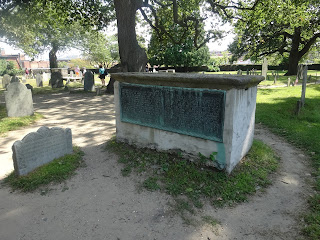The Charter Street
Cemetery opened in 1637, though evidently
the spot was already being used for burials almost a decade before that.
So what is the oldest surviving stone in the cemetery?
One 19th century guidebook mentions that the
oldest legible stone is dated 1650. I
have looked for that stone, but haven’t been able to find it. Perhaps I missed it, perhaps it is no longer
legible.
When the question comes up, most people will point to the stone
of Doraty Cromwell, which is dated 1673.
Doraty was the third of Philip Cromwell’s five wives; she is buried next
to him, and her stone shows classic death’s head and hourglass imagery common
to early New England gravestones.
I have pointed this stone out to people on my tours,
commenting that the stone is so old, and the workmanship so simple, almost primitive,
that it somehow seems modern. The
simplicity of the designwork makes it look, at least to me, almost Art Deco. So old, it looks new.
But then I discovered something odd.
Frank Cousins was a noted Salem
photographer, active in the early 20th century. He spent much of his time photographing older
buildings and landmarks around town (for which we are forever grateful!). He took a number of photographs in the Charter
Street Cemetery,
and Doraty’s stone is one of them.
It’s obvious at a glance that THAT stone is very different
from the stone that is there now. There
is much more detail – check out the feathers on the wings, the graceful
curlicue eyebrows on the skull. Cousins’s
photo shows crossbones on the left-hand side, but today we have a second
hourglass instead.
And the inscription is also noticeably different – the “memento
mori” in Cousins’s photograph is completely gone, the E in “ye” is larger, and
crossbar on the H in
”Philip” was straight and now is curved.
And on and on.
But there are similarities as well – they are the same shape,
they both have a large chip along the top edge.
The H and the E in “Here” run together on both.
What’s the story here?
Is it the same stone, just completely re-carved (which only raises
further questions of Why and When)? Is
it a replacement stone that was carved to resemble the original (again, Why and
When)? What happened to the original
stone, if this isn’t it?
If I find out anything, you will be the first to know.
(My thanks to Donovan Loucks, webmaster of the excellent and
thorough
www.hplovecraft.com, for drawing my
attention to the Cousins photo.
Thanks,
dude!)









